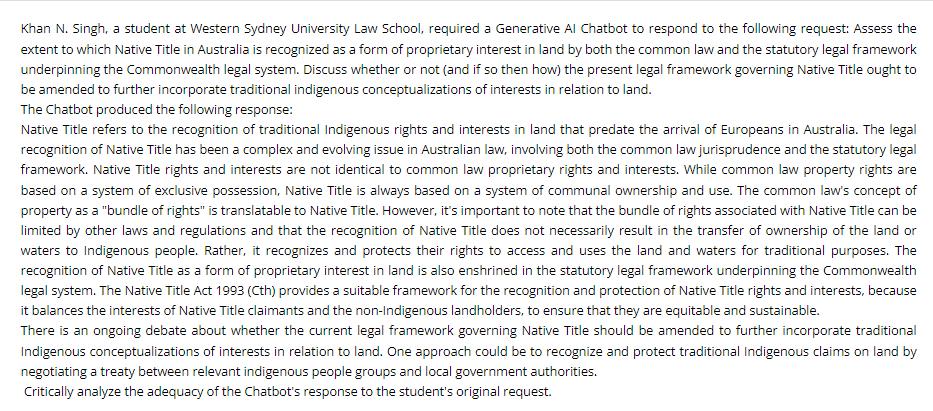Answered step by step
Verified Expert Solution
Question
1 Approved Answer
Khan N. Singh, a student at Western Sydney University Law School, required a Generative Al Chatbot to respond to the following request: Assess the

Khan N. Singh, a student at Western Sydney University Law School, required a Generative Al Chatbot to respond to the following request: Assess the extent to which Native Title in Australia is recognized as a form of proprietary interest in land by both the common law and the statutory legal framework underpinning the Commonwealth legal system. Discuss whether or not (and if so then how) the present legal framework governing Native Title ought to be amended to further incorporate traditional indigenous conceptualizations of interests in relation to land. The Chatbot produced the following response: Native Title refers to the recognition of traditional Indigenous rights and interests in land that predate the arrival of Europeans in Australia. The legal recognition of Native Title has been a complex and evolving issue in Australian law, involving both the common law jurisprudence and the statutory legal framework. Native Title rights and interests are not identical to common law proprietary rights and interests. While common law property rights are based on a system of exclusive possession, Native Title is always based on a system of communal ownership and use. The common law's concept of property as a "bundle of rights" is translatable to Native Title. However, it's important to note that the bundle of rights associated with Native Title can be limited by other laws and regulations and that the recognition of Native Title does not necessarily result in the transfer of ownership of the land or waters to Indigenous people. Rather, it recognizes and protects their rights to access and uses the land and waters for traditional purposes. The recognition of Native Title as a form of proprietary interest in land is also enshrined in the statutory legal framework underpinning the Commonwealth legal system. The Native Title Act 1993 (Cth) provides a suitable framework for the recognition and protection of Native Title rights and interests, because it balances the interests of Native Title claimants and the non-Indigenous landholders, to ensure that they are equitable and sustainable. There is an ongoing debate about whether the current legal framework governing Native Title should be amended to further incorporate traditional Indigenous conceptualizations of interests in relation to land. One approach could be to recognize and protect traditional Indigenous claims on land by negotiating a treaty between relevant indigenous people groups and local government authorities. Critically analyze the adequacy of the Chatbot's response to the student's original request.
Step by Step Solution
There are 3 Steps involved in it
Step: 1
The Chatbots response addresses the main aspects of the students original request to assess the extent to which Native Title in Australia is recognize...
Get Instant Access to Expert-Tailored Solutions
See step-by-step solutions with expert insights and AI powered tools for academic success
Step: 2

Step: 3

Ace Your Homework with AI
Get the answers you need in no time with our AI-driven, step-by-step assistance
Get Started


